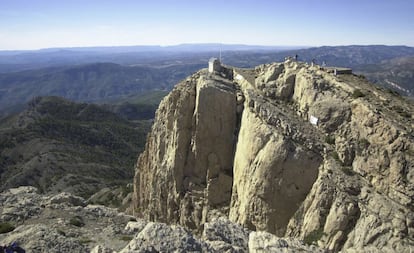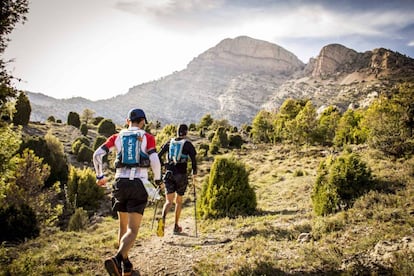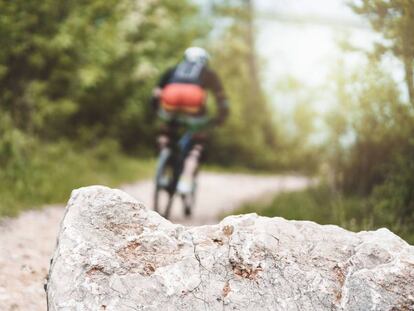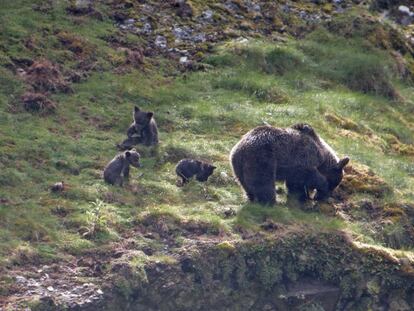In Spain, Valencia government buys landmark peak known as ‘Stone Giant’
In a bid to preserve the second-highest mountain on their territory, regional authorities have purchased a third of the summit from private owners for €1.14 million


On a clear day, from an altitude of 1,813 meters at the top of Penyagolosa, the second-highest mountain in Spain’s Valencia region, it is possible to see the Ebro river mouth, the Cape of San Antonio in Alicante, and even the Balearic Islands.
Although it is a well-known natural landmark, few people know that the top of this mountain, located in Castellón province, is in private hands. After declaring the mountain and the space around it a natural park, the Valencia regional government has bought a third of the summit for €1.14 million. From now on, 150 hectares of this peak, which is known as the Stone Giant (Gegant de Pedra in the Valencian language), are now part of public heritage.
We would like for everything to be restored so that it will have a good future. Somehow it is still ours because it is public
Charo, Mas de Sanahuja farmhouse heir
It’s been more than two years since the Valencia executive first showed an interest in acquiring the second-tallest mountain in the region after Cerro Calderón, which has an elevation of 1,838 meters. Regional premier Ximo Puig revealed the purchase a few months ago, but the move did not get approval until this past December and it was made official three weeks ago by a notary in Castellón. On Sunday, a symbolic act was held at the summit and attended by the regional leader. “It is much more than an incredible natural space, it also holds great emotional value for us,” said Puig.
At the top of Penyagolosa, there are at least two private estates: the Mas de Sanahuja, with 150 hectares, and La Cambreta, covering 400 hectares. The Valencia government has bought the first, where the primary access trail to the summit is located. While the purchase had been under consideration for a long time, the government was persuaded to start negotiations when the owners of La Cambreta applied for a license to exploit a large game preserve.
“We got in touch with the third generation of owners of Mas de Sanahuja, which includes 11 heirs, and with the owners of La Cambreta. We encountered willingness with the first estate, but not so much with the second,” says Adolf Sanmartín, a Valencia government official. Valuations and appraisals were made, and there was even the insinuation of expropriation, but in the end the deal was closed. Similar efforts with the owners of the larger estate did not prosper.

There is no doubt about Penyagolosa’s value. It belongs to Red Natura 2000, a network of nature protection areas in the European Union; it has areas of special protection for birds; it is a reference point for hikers, and now hosts a mountain racing competition, which draws competitors from around the world. It is also home to the sanctuary of Saint Joan of Penyagolosa, a local pilgrimage site that has great tourism potential.
For the heirs of Mas de Sanahuja, the property has more sentimental than economic value.“As it is a natural park, activity is limited. You need a lot of money to restore the farmhouse and buy out the rest of the shares. This is why, in the end, a decision was made to sell,” says Charo, whose grandmother bought the farmhouse in 1945.
The farmhouse is full of stories and anecdotes, and not all of them are good. Charo remembers the hardships that her ancestors endured after the Spanish Civil War, the Maquis guerrilla fighters who raided the place looking for food, and the Civil Guard’s reprisals. When her grandmother died in 1974, the estate’s heirs distanced themselves from the property. Although they received purchase offers, it was hard to settle upon one due to the fragmented nature of the estate.
We have to take care of the mountain and preserve the landscape because humans devour everything in their path
Carmen, Vistabella local
Since the 1980s, visitor numbers have multiplied. “We would like for everything to be restored so that it will have a good future. Somehow it is still ours because it is public,” says Charo.
For Vistabella, one of the three municipalities that Penyagolosa towers over, the natural park is of vital importance. Belén Bachero, the mayor of this village of 350 inhabitants, hopes that efficient management will accompany the purchase. “I suppose that Puig will meet with the mayors of the area to see what use we can give it. We hope that the mountain will be revitalized because we live off of it,” says Bachero, who once officiated a marriage on Penyagolosa’s summit.
Carmen, a local resident who preferred not to give her surname, has lived in the area for the past 25 years and knows the farmhouses and its shepherds. Gregorio, the only one of them who still frequents the mountain pastures, will retire in a year or two. It will be the first time since the Middle Ages that there will be no grazing in that part of the summit, even though it is believed that grazing has helped prevent wildfires on the mountain.
Pressure on the Stone Giant grows with every passing year. “There are months when visitor numbers to the top soar above 3,000 [when the weather is nice],” explains Carmen. “We have to take care of the mountain and preserve the landscape, because we humans devour everything in our path.”
English version by Asia London Palomba.
Tu suscripción se está usando en otro dispositivo
¿Quieres añadir otro usuario a tu suscripción?
Si continúas leyendo en este dispositivo, no se podrá leer en el otro.
FlechaTu suscripción se está usando en otro dispositivo y solo puedes acceder a EL PAÍS desde un dispositivo a la vez.
Si quieres compartir tu cuenta, cambia tu suscripción a la modalidad Premium, así podrás añadir otro usuario. Cada uno accederá con su propia cuenta de email, lo que os permitirá personalizar vuestra experiencia en EL PAÍS.
¿Tienes una suscripción de empresa? Accede aquí para contratar más cuentas.
En el caso de no saber quién está usando tu cuenta, te recomendamos cambiar tu contraseña aquí.
Si decides continuar compartiendo tu cuenta, este mensaje se mostrará en tu dispositivo y en el de la otra persona que está usando tu cuenta de forma indefinida, afectando a tu experiencia de lectura. Puedes consultar aquí los términos y condiciones de la suscripción digital.
More information
Archived In
Últimas noticias
Pinochet’s victims grapple with José Antonio Kast’s rise in Chile
Reinhard Genzel, Nobel laureate in physics: ‘One-minute videos will never give you the truth’
How Japan is trying to avert ‘digital defeat’
The complicated life of Francesca Albanese: A rising figure in Italy but barred from every bank by Trump’s sanctions
Most viewed
- Pablo Escobar’s hippos: A serious environmental problem, 40 years on
- Why we lost the habit of sleeping in two segments and how that changed our sense of time
- Charles Dubouloz, mountaineering star, retires at 36 with a farewell tour inspired by Walter Bonatti
- Trump’s obsession with putting his name on everything is unprecedented in the United States
- The Florida Keys tourist paradise is besieged by immigration agents: ‘We’ve never seen anything like this’










































